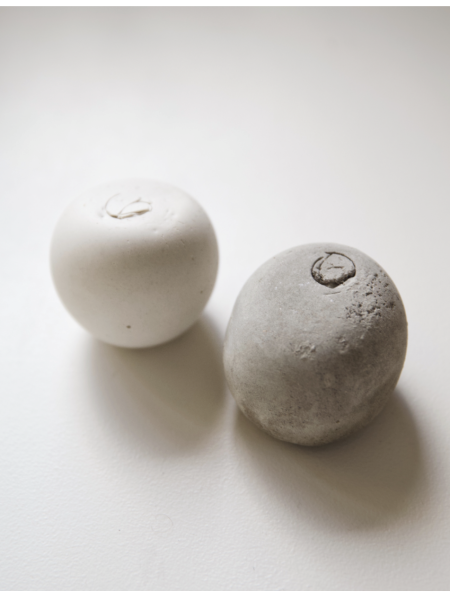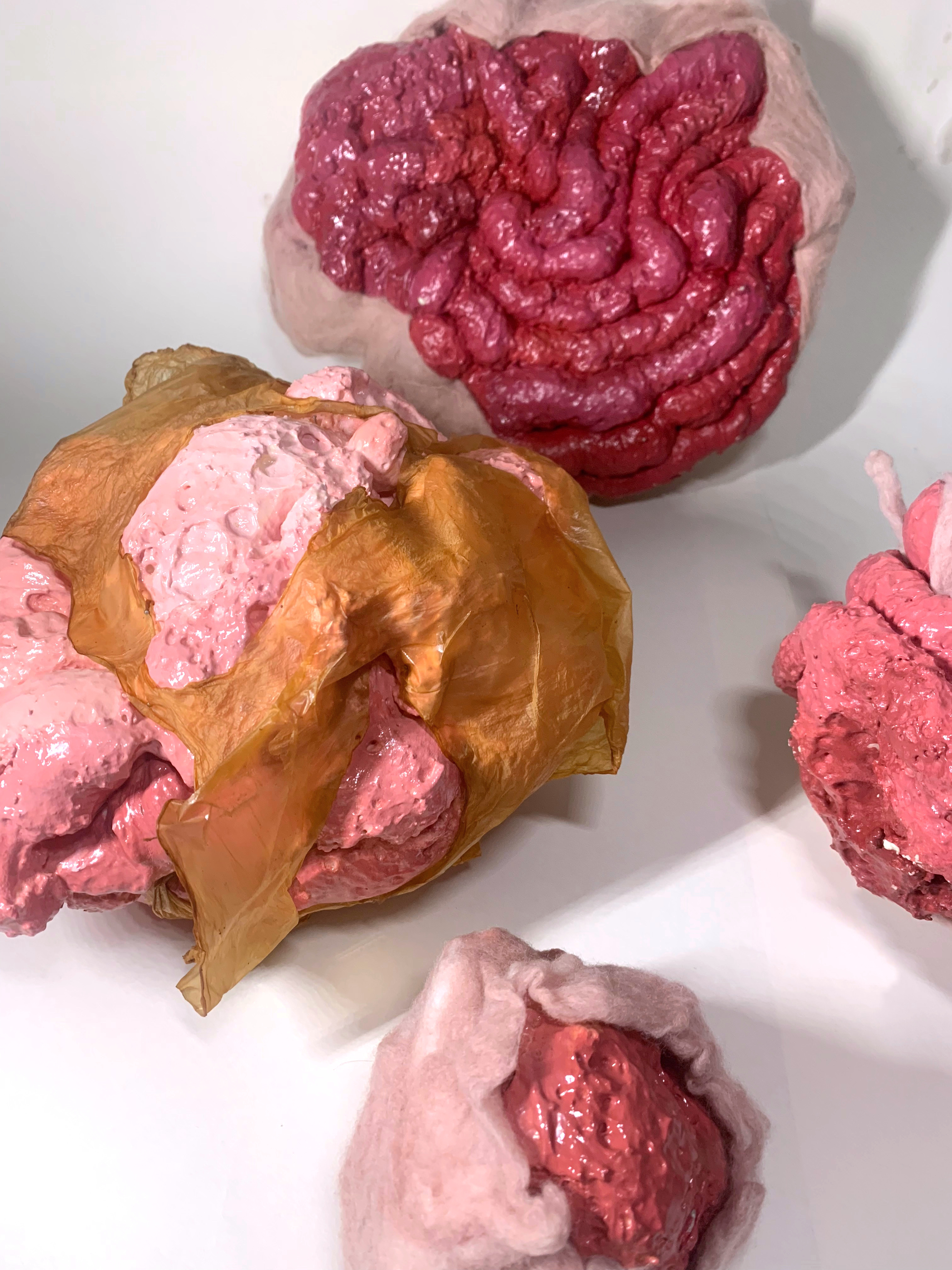My Brain But Not My Brain
Annabel Scanlen, Annie Areum Shin, Fei Gao, Jessie Nok Wai Hui, Jodie Sim, Karan Singh Shekhawat, Natalie Quan Yau TsoExhibition Opening Thursday July 30, 6 PM (via Facebook Livestream)
Exhibition Continues July 30th- August 15th 2020
Emotions engendered by the subconscious intertwine our waking and dreaming lives. Shekhawat's paintings are layered flashbacks of nightmares that illustrate the perpetration of fear from day to dreams and from dreams to light. Meanwhile, the inescapable state of 'self' against emotions is mirrored in Hui's intuitive ink drawings of cloudscapes. The clouds, as the subconscious, cycle on its own emotional states, while the character Hui, as the reaction, is constantly attempting to shape its unruly mass. The series articulates a narrative of the changing yet patterned subconscious.
Beyond emotions, the subconscious undermines decision making. Scanlen's nonfunctional sculptures challenge the dualism between humans and Things. She tests the notion of utility in relation to Thing by collaborating with it, enquiring human's disregard for Things' 'hidden' brains. The prioritisation of the 'hidden' brain is echoed in Shin's Qualia Series. She utilises an equation-like manner to collage her paintings that realise and translate the qualitative biases that limit her visual window. The aesthetic norms and preferences of her marks are alien and autonomic montages of the visual world by her subconscious.
The subconscious not only builds our present identities but conjures the past identities that are lost. Tso's video performance manifests the loss of her mother tongue as she escapes the facemask and chews on a new skin. She laments the trauma weighing on her relationship with her mother, mother tongue and motherland. In symmetry, Gao evokes the childhood yearning for his father in Is Dad Still Not Back? As one rolls the ball between wooden words, time is passed to endure the absence of a loved one. This time is stretched and embedded in Sim's Mending of Flesh. By inducing mnemonic qualities of mourning, the absence and presence of grief and loss that overpowers our subconscious begins healing.
Artists
Annabel Scanlen She / Her
Annabel Scanlen is a Sydney based artist whose practice involves extensive experimentation with tactile media. Scanlen's process often begins on paper, through sketching and illustration, then expands to three dimensional forms, through use of textile, cement, plaster and clay. This can be seen through her sculptural series Thing. Scanlen's theoretical practice interrogates notions of Thing Power, taking specific inspiration from Jane Bennett's approach to Thing and its value.
Follow Annabel on Instagram.
Image: Annabel Scanlen, Assembly of Things, 2020, cement and plaster sculptures, 7x5x5 cm. & 6x5x5cm.
Annabel Scanlen is a Sydney based artist whose practice involves extensive experimentation with tactile media. Scanlen's process often begins on paper, through sketching and illustration, then expands to three dimensional forms, through use of textile, cement, plaster and clay. This can be seen through her sculptural series Thing. Scanlen's theoretical practice interrogates notions of Thing Power, taking specific inspiration from Jane Bennett's approach to Thing and its value.
Follow Annabel on Instagram.
Image: Annabel Scanlen, Assembly of Things, 2020, cement and plaster sculptures, 7x5x5 cm. & 6x5x5cm.

Annie Areum Shin (She / her)
Annie Areum Shin is a Sydney based Korean-Australian artist whose practice employs an 'art for my sake' approach to realise and elucidate the psychological processes and frameworks that underlie her aesthetical choices. Her focus on material exploration, abstraction and collage across painting, sculpture and installation allow mimicry of her mental space and the dialogues that unfold within.
Shin's artmaking is a platform of escape from the influx of information, reality, demand for sociopolitical themes and identity exploration in art. Instead, she turns to inward queries of angst and internalisations, the failures and successes of applied psychology and fragments of the self that were birthed from them.
Website.
Follow Annie on Instagram.
Image: Annie Areum Shin, Add-ons in waiting, ‘Qualia’ Series, 2019, Mixed media on canvas, 100x70cm.
Annie Areum Shin is a Sydney based Korean-Australian artist whose practice employs an 'art for my sake' approach to realise and elucidate the psychological processes and frameworks that underlie her aesthetical choices. Her focus on material exploration, abstraction and collage across painting, sculpture and installation allow mimicry of her mental space and the dialogues that unfold within.
Shin's artmaking is a platform of escape from the influx of information, reality, demand for sociopolitical themes and identity exploration in art. Instead, she turns to inward queries of angst and internalisations, the failures and successes of applied psychology and fragments of the self that were birthed from them.
Website.
Follow Annie on Instagram.
Image: Annie Areum Shin, Add-ons in waiting, ‘Qualia’ Series, 2019, Mixed media on canvas, 100x70cm.
Jessie Nok Wai Hui (She / her)
Jessie Nok Wai Hui is currently a Honours student of Bachelor of Fine Arts in University of New South Wales, who is from Hong Kong. Hui's art practice is often an outlet for reflection on everyday events that she encounters. Discussing various topics such as slowness, social identity, emotions and subconsciousness, Hui's work in oil painting and ink drawing combines the imaginary and reality to offer a new perspective in viewing herself and her surroundings.
Website.
Follow Jessie on Instagram.
Image: Jessie Nok Wai Hui, Lunar Phases Series (Detail Shot), 2020, Ink on Paper, 56cm x 75cm.
Jessie Nok Wai Hui is currently a Honours student of Bachelor of Fine Arts in University of New South Wales, who is from Hong Kong. Hui's art practice is often an outlet for reflection on everyday events that she encounters. Discussing various topics such as slowness, social identity, emotions and subconsciousness, Hui's work in oil painting and ink drawing combines the imaginary and reality to offer a new perspective in viewing herself and her surroundings.
Website.
Follow Jessie on Instagram.
Image: Jessie Nok Wai Hui, Lunar Phases Series (Detail Shot), 2020, Ink on Paper, 56cm x 75cm.

Jodie Sim (She / her)
Jodie Sim is a Warrang (Sydney) based multidisciplinary artist engaged in documenting the diasporic experiences of familiarity and a sense of home. Her art practice often explores the complexities of cultural identity through material investigation of the mnemonic qualities of tactile sensory experiences. Jodie centralises her practice around methods of haptic repetition, intuitive making as response to sensory cues, and language and translation to produce works embodying the performed experiences of the diaspora.
Follow Jodie on Instagram.
Image: Jodie Sim, Mending of flesh, 2020, mixed media sculpture, dimensions varying.
Jodie Sim is a Warrang (Sydney) based multidisciplinary artist engaged in documenting the diasporic experiences of familiarity and a sense of home. Her art practice often explores the complexities of cultural identity through material investigation of the mnemonic qualities of tactile sensory experiences. Jodie centralises her practice around methods of haptic repetition, intuitive making as response to sensory cues, and language and translation to produce works embodying the performed experiences of the diaspora.
Follow Jodie on Instagram.
Image: Jodie Sim, Mending of flesh, 2020, mixed media sculpture, dimensions varying.

Karan Singh Shekhawat (He/him)
Karan Singh Shekhawat's practice revolves around gender stereotypes, formed by society and how they impact one's identity. Growing up in India and living in Australia, Karan's work portrays the struggles of living in two worlds with opposing ideologies about one's sexuality, compelling him to live with dual personalities. Most of his works are constantly evolving self-portraits, combining various mediums to form installations with elements of painting, drawing, animation, and performance.
Website.
Follow Karan on Instagram.
Image: Karan Singh Shekhawat, Maa, 2020, Acrylics on canvas, 150X100cm.

Natalie Quan Yau Tso (She / her)
Natalie Tso is a Hong Kong-Australian artist working on Cammeraygal land. She creates sculptures and self-performances to remember, examine and transmute trauma. Her creative process prioritises bodily memories and sensations. She works with hair, facemasks, threads and clay to translate bodily shock into materiality, rebodies these materials and reconfigures each performance's residues to complete sculptures.
Tso's art and love practice are two threads that coalesce to mend trauma in order to decolonise internally. This journey alchemises buried trauma to cultivate resilience against fear. Since encounters of pain between objects solidify the boundaries of our skin, art about suffering reshapes intimate and political relationships. Her narratives of injury become political warfare as her healing body, self and artworks redefine healing bodies around her.
Website.
Follow Natalie on instagram.
Image: Natalie Tso, Out-Coming, 2020, Video Performance [eating still].
Natalie Tso is a Hong Kong-Australian artist working on Cammeraygal land. She creates sculptures and self-performances to remember, examine and transmute trauma. Her creative process prioritises bodily memories and sensations. She works with hair, facemasks, threads and clay to translate bodily shock into materiality, rebodies these materials and reconfigures each performance's residues to complete sculptures.
Tso's art and love practice are two threads that coalesce to mend trauma in order to decolonise internally. This journey alchemises buried trauma to cultivate resilience against fear. Since encounters of pain between objects solidify the boundaries of our skin, art about suffering reshapes intimate and political relationships. Her narratives of injury become political warfare as her healing body, self and artworks redefine healing bodies around her.
Website.
Follow Natalie on instagram.
Image: Natalie Tso, Out-Coming, 2020, Video Performance [eating still].

















